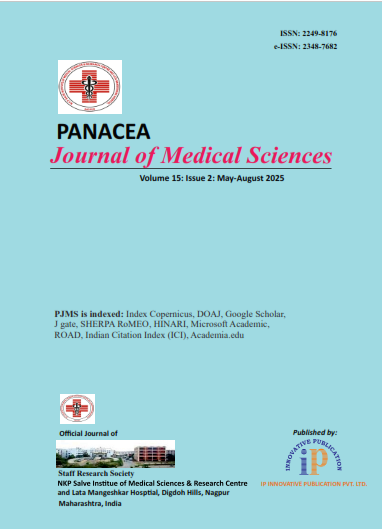Panacea Journal of Medical Sciences
Panacea Journal of Medical Sciences (PJMS) open access, peer-reviewed triannually journal publishing since 2011 and is published under auspices of the “NKP Salve Institute of Medical Sciences and Research Centre”. With the aim of faster and better dissemination of knowledge, we will be publishing the article ‘Ahead of Print’ immediately on acceptance. In addition, the journal would allow free access (Open Access) to its contents, which is likely to attract more readers and citations to articles published in PJMS.Manuscripts must be prepared in accordance with “Uniform requiremen...

Aerobic microbiological profile and antibiogram in sterile body fluids from a tertiary care centre in Kashmir Valley
Page: 388-392
Background: Infections involving sterile bodily fluids, particularly those linked to healthcare settings are substantial and major sources of mortality and morbidity. The identification of species-level bacteria and their antimicrobial resistance profile are crucial factors to consider when choosing the right antimicrobials for both empirical and targeted therapy.
Aim and Objective: The aim of study was to identify the bacterial isolates in the sterile body fluids and study their antimicrobial resistance pattern.
Materials and Methods: A retrospective observational study was carried in the Department of Microbiology of SKIMS Medical College, Bemina, Srinagar, a tertiary care hospital for a period of 1 year. All sterile body fluid samples received in the Microbiology department were cultured aerobically and then identified up to species level using conventional biochemicals in accordance with established microbiological methods. The antimicrobial susceptibility of bacterial pathogens produced in culture was examined using the Kirby-Bauer disk diffusion method, and results were interpreted in accordance with CLSI recommendations.
Results: A total of 650 clinical samples were processed for a period of 1 year; of them 72 showed Positive bacterial growth. 52 (72.2%) were Gram Negative Bacteria and 20 (27.7%) were Gram Positive Bacteria. CSF samples (280) constituted 43.07%, pleural fluid samples (188) 28.92%, peritoneal fluid (114) 17.5%, synovial fluid (56) 8.6% and bile (12)1.84.Escherichia coli was the most prevalent of the 52 Gram-Negative isolates (24.50%), and Staphylococcus aureus and CONS (12.5%) were most prevalent in Gram Positives. Most Gram Negatives showed Multi Drug resistance but were fully sensitive to colistin and polymyxin B, In Gram positives, Vancomycin and Linezolid showed 100 sensitivity.
Conclusion: This study identified emerging ESKAPE organisms. The presence of multidrug resistance patterns in bacterial isolates highlights the need for further research in various parts of the country to prevent needless antibiotic use and resistance development.
Article Metrics
- Visibility 16 Views
- Downloads 5 Views
- DOI 10.18231/pjms.v.15.i.2.388-392
-
CrossMark
- Citation
- Received Date October 04, 2024
- Accepted Date March 10, 2025
- Publication Date August 19, 2025